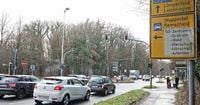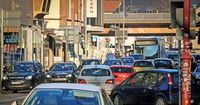Across several German regions, drivers are facing significant traffic challenges as a combination of new construction projects, accidents, and overloaded routes slow down journeys. From Nienburg in Lower Saxony to the bustling roads of North Rhine-Westphalia and the surroundings of Gifhorn, up-to-date traffic information has become crucial for commuters navigating these frequently congested areas.
In Nienburg and its district, motorists encounter delays on major highways including the Autobahns A2, A37, A7, A27, and A1, as well as on Bundesstraßen such as B6, B215, B214, B482, B62, B239, B51, B442, and B441. The traffic data here is sourced from TomTom, a navigation technology company that compiles information from GPS coordinates of millions of devices, alongside automatic data from around 80 million mobile phones and millions of official road sensors. This comprehensive data is updated every five minutes, providing real-time insights into traffic jams, accident warnings, and overloaded routes. The Nienburg traffic alert service emphasizes that drivers should always exercise caution and consideration toward other road users.
Similarly, the Marburg region and the district of Marburg-Biedenkopf face traffic slowdowns on several important Bundesstraßen, including B3, B62, B236, B252, B253, B255, B453, and B454, along with key state roads. The OP-Staumelder in Marburg relies on the same TomTom data system, ensuring that residents receive timely updates to navigate around congestion and disruptions effectively. The data's accuracy is bolstered by manual information maintenance, supplementing the automatic streams from mobile and sensor sources.
Moving to North Rhine-Westphalia, the traffic situation grows even more complex and demanding. In the Remscheid area, which includes Wermelskirchen, Solingen, and Wuppertal, congestion is a daily reality on Autobahns A1 and A46, Bundesstraßen B51, B51n, B229, B237, B483, and state roads L74, L81, L101, and L418. According to the Allgemeiner Deutscher Automobil-Club (ADAC), the autobahns in this region rank among the most congested in Germany. For instance, the A1 between Cologne and Dortmund saw nearly 6,500 hours of traffic jams in 2023, marking it as a national congestion hotspot. The A46, connecting Düsseldorf and Wuppertal, is the sixth most congested route in North Rhine-Westphalia and serves as a vital corridor for commuters heading toward the Ruhr area and beyond.
One of the most ambitious infrastructure undertakings in the region is the ongoing reconstruction of the Wuppertal-Nord autobahn interchange. This mammoth project is expected to span the next decade and aims to alleviate some of the chronic congestion issues. Meanwhile, several Bundesstraßen such as B229, which cuts through Radevormwald and Remscheid, and B237, important for commuters near the Am Eichholz industrial area, remain heavily trafficked. The L74, known locally as "Kohlfurth," connects Müngsten to the Wuppertal-Sonnborn interchange and is another critical artery frequently affected by traffic jams.
In the neighboring city of Solingen, the traffic woes are equally pronounced. The ST-Staumelder reports congestion on Autobahns A1, A3, and A46, Bundesstraßen B229 and B224, and state roads including L74 and L357, as well as numerous local streets such as Cronenberger Straße and Katternberger Straße. The A3 is particularly notorious, topping the ADAC's list as the most congested autobahn in North Rhine-Westphalia. Commuters on the stretch between Cologne and Oberhausen spent over 10,000 hours stuck in traffic in 2023. Compounding the problem, months-long construction work at the A3 Solingen junction, involving closures and detours, has intensified delays.
The A46 again plays a dual role for Solingen residents, linking them not only to Wuppertal and the Ruhr district but also to Düsseldorf and the A3, one of Germany's key north-south routes. The A1, with its heavy congestion between Cologne and Dortmund, adds to the pressure on local roads. Bundesstraßen like B229, which traverses Solingen and connects to Remscheid, and B224, linking Solingen-Mitte with Wuppertal-Vohwinkel, are vital commuter routes but often congested. Local connectors such as the L357 Roggenkamp tie neighborhoods to the autobahn network, while the "Stadtautobahn" Viehbachtalstraße and other local streets bear heavy traffic loads.
Gifhorn and its surrounding areas also rely on detailed traffic updates to manage travel on Autobahns A2 and A39, as well as Bundesstraßen B188, B4, B214, B248, and the state road K114. The AZ-Staumelder provides timely information based on the same robust TomTom data network. This ensures drivers in the region are kept abreast of any unexpected delays or accidents, allowing for better route planning.
Across all these regions, the common thread is the reliance on TomTom's extensive data collection, which integrates GPS tracking from millions of devices, automatic inputs from mobile phones and official sensors, and manually curated information. The data refreshes every five minutes, offering near real-time snapshots of traffic conditions. Other navigation services like Google Maps, Apple Maps, and Garmin also provide traffic information, but these local alert systems tailor updates specifically for their respective areas.
The ADAC's 2023 statistics underline the severity of congestion on many of these routes, especially in North Rhine-Westphalia, where autobahns A1, A3, and A46 consistently rank among the top ten most congested in the state. The ongoing infrastructure projects, such as the Wuppertal-Nord interchange reconstruction, highlight the long-term efforts to address these challenges, though drivers must contend with disruptions in the meantime.
Ultimately, these traffic monitoring services serve as essential tools for daily commuters and travelers, offering crucial guidance through complex and often congested road networks. They also remind everyone to drive considerately and remain aware of fellow road users, especially amid construction zones and accident sites where conditions can change rapidly.





